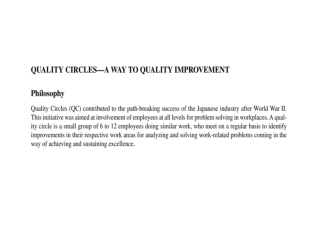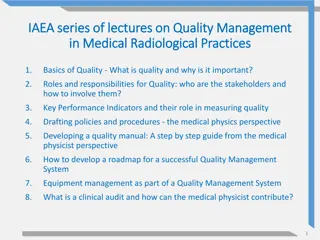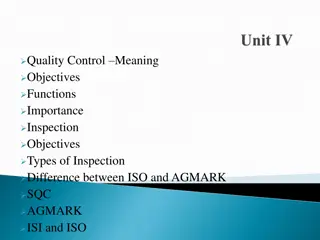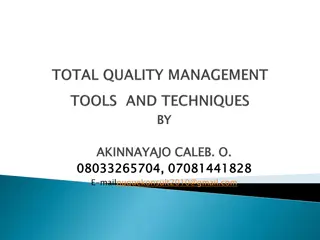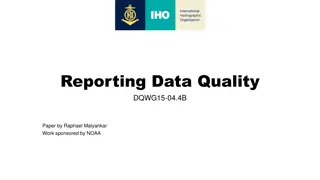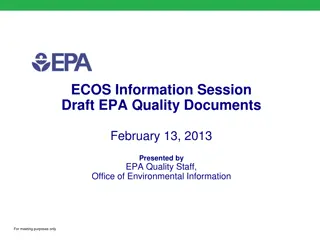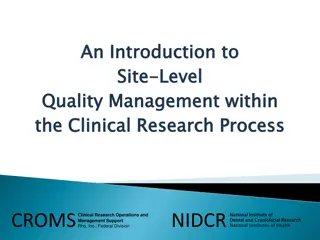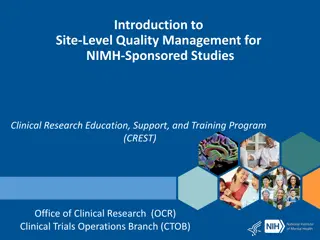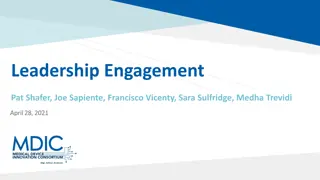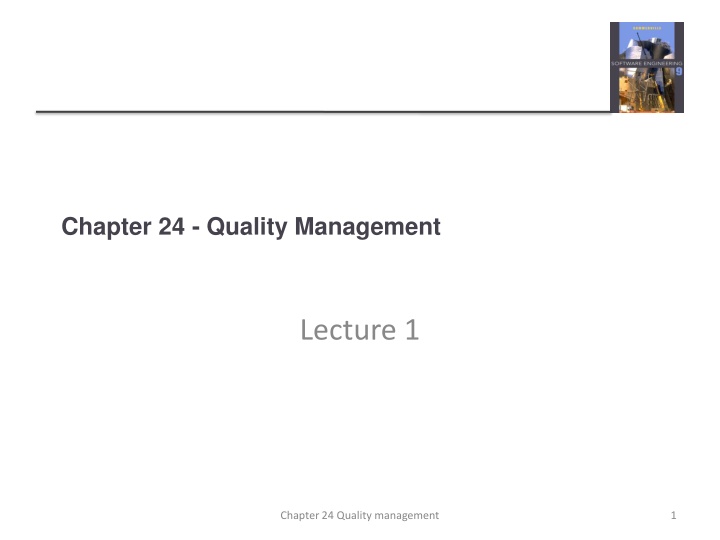
Software Quality Management Essentials
Explore the key aspects of software quality management, including organizational processes, quality planning, quality assessment, and quality plans. Learn how quality management ensures high-quality software products through independent checks and adherence to standards.
Download Presentation

Please find below an Image/Link to download the presentation.
The content on the website is provided AS IS for your information and personal use only. It may not be sold, licensed, or shared on other websites without obtaining consent from the author. If you encounter any issues during the download, it is possible that the publisher has removed the file from their server.
You are allowed to download the files provided on this website for personal or commercial use, subject to the condition that they are used lawfully. All files are the property of their respective owners.
The content on the website is provided AS IS for your information and personal use only. It may not be sold, licensed, or shared on other websites without obtaining consent from the author.
E N D
Presentation Transcript
Chapter 24 - Quality Management Lecture 1 Chapter 24 Quality management 1
Topics covered Software quality Software standards Reviews and inspections Software measurement and metrics Chapter 24 Quality management 2
Software quality management Concerned with ensuring that the required level of quality is achieved in a software product. Three principal concerns: At the organizational level, quality management is concerned with establishing a framework of organizational processes and standards that will lead to high-quality software. At the project level, quality management involves the application of specific quality processes and checking that these planned processes have been followed. At the project level, quality management is also concerned with establishing a quality plan for a project. The quality plan should set out the quality goals for the project and define what processes and standards are to be used. Chapter 24 Quality management 3
Quality management activities Quality management provides an independent check on the software development process (Fig.). The quality management process checks the project deliverables to ensure that they are consistent with organizational standards and goals. The quality team should be independent from the development team so that they can take an objective view of the software. This allows them to report on software quality without being influenced by software development issues. Chapter 24 Quality management 4
Quality management and software development Chapter 24 Quality management 5
Quality planning A quality plan sets out the desired product qualities and how these are assessed and defines the most significant quality attributes. The quality plan should define the quality assessment process. It should set out which organisational standards should be applied and, where necessary, define new standards to be used. Chapter 24 Quality management 6
Quality plans Quality plan structure Product introduction; Product plans; Process descriptions; Quality goals; Risks and risk management. Quality plans should be short, succinct documents If they are too long, no-one will read them. Chapter 24 Quality management 7
1. Software Quality Quality, simplistically, means that a product should meet its specification. This is problematical for software systems It is difficult to write complete and unambiguous requirements. Software specifications are usually incomplete and often inconsistent. It is impossible to characteristics. (Eg. Maintainability) Because of these, assessment of software quality is subjective process.. measure some quality Chapter 24 Quality management 8
Software fitness for purpose Questions to be answered about system characteristics Have programming and documentation standards been followed in the development process? Has the software been properly tested? Is the software sufficiently dependable to be put into use? Is the performance of the software acceptable for normal use? Is the software usable? Is the software well-structured and understandable? Chapter 24 Quality management 9
Software quality attributes Safety Understandability Portability Security Testability Usability Reliability Adaptability Reusability Resilience Modularity Efficiency Robustness Complexity Learnability Chapter 24 Quality management 10
Process and Product quality The quality of a developed product is influenced by the quality of the production process. This is important in software development as some product quality attributes are hard to assess. However, there is a very complex and poorly understood relationship between software processes and product quality. But, there exist a clear link between these in manufacturing. Chapter 24 Quality management 11
Process-based quality Chapter 24 Quality management 12
2. Software standards Standards define the required attributes of a product or process. They play an important role in quality management. Standards may be international, national, organizational or project standards. Product standards define characteristics that all software components should exhibit. e.g. a common programming style. Chapter 24 Quality management 13
Importance of standards Standards capture wisdom that is of value to the organisation. Based on the knowledge about the best or most appropriate practice for the company. They are a framework for defining what quality means in a particular setting i.e. that organization s view of quality. They provide continuity - new staff can understand the organisation by understanding the standards that are used. Product Standards Process Standards Chapter 24 Quality management 14
Product and Process standards Product standards Process standards Design review form Design review conduct Requirements document structure Submission of new code for system building Method header format Version release process Java programming style Project plan approval process Project plan format Change control process Change request form Test recording process Chapter 24 Quality management 15
Problems with standards They may not be seen as relevant and up-to-date by software engineers. They often involve too much bureaucratic form filling. If they are unsupported by software tools, tedious form filling work is often involved documentation associated with the standards. to maintain the Chapter 24 Quality management 16
Standards development steps 1. Involve software engineers in the selection of product standards. 2. Review and modify standards regularly to reflect changing technologies. 3. Provide software tools to support standards. Chapter 24 Quality management 17
ISO 9001 standards framework It is an international set of standards that can be used as a basis for developing quality management systems. ISO 9001, the most general of these standards, applies to organizations that design, develop and maintain products, including software. The ISO 9001 standard is a framework for developing software standards. It sets out general quality principles, describes quality processes in general and lays out the organizational standards and procedures that should be defined. These should be documented in an organizational quality manual. Chapter 24 Quality management 18
ISO 9001 core processes Chapter 24 Quality management 19
ISO 9001 and quality management Chapter 24 Quality management 20
ISO 9001 certification Quality documented in an organisational quality manual. standards and procedures should be An external body may certify that an organisation s quality manual conforms to ISO 9000 standards. Some customers require suppliers to be ISO 9000 certified although the need for flexibility here is increasingly recognised. Chapter 24 Quality management 21
3. Reviews and Inspections A group examines part or all of a process or system and its documentation to find potential problems. Software or documents may be 'signed off' at a review which signifies that progress to the next development stage has management. been approved by There are different types of review with different objectives Inspections for defect removal (product); Reviews for progress assessment (product and process); Quality reviews (product and standards). Chapter 24 Quality management 22
The software review process Three Phases, 1. Pre-review activities 2. The review meeting 3. Post-review activities Chapter 24 Quality management 23
Program inspections These are peer reviews where engineers examine the program that is being developed, to find bugs, anomalies and defects. Inspections do not require execution of a system so may be used before implementation. They may be applied to any representation of the system (requirements, design, configuration data, test data, etc.) They have been shown to be an effective technique for discovering program errors. Chapter 24 Quality management 24
Inspection checklists Checklist of common errors should be used to drive the inspection. Error dependent and reflect the characteristic errors that are likely to arise in the language. checklists are programming language In general, the 'weaker' the type checking, the larger the checklist. Examples: termination, array bounds, etc. Initialisation, Constant naming, loop Chapter 24 Quality management 25
An inspection checklist (a) Fault class Inspection check Data faults Are all program variables initialized before their values are used? Have all constants been named? Should the upper bound of arrays be equal to the size of the array or Size -1? If character strings are used, is a delimiter explicitly assigned? Is there any possibility of buffer overflow? Control faults For each conditional statement, is the condition correct? Is each loop certain to terminate? Are compound statements correctly bracketed? In case statements, are all possible cases accounted for? If a break is required after each case in case statements, has it been included? Input/output faults Are all input variables used? Are all output variables assigned a value before they are output? Can unexpected inputs cause corruption? Chapter 24 Quality management 26
An inspection checklist (b) Fault class Inspection check Interface faults Do all function and method calls have the correct number of parameters? Do formal and actual parameter types match? Are the parameters in the right order? If components access shared memory, do they have the same model of the shared memory structure? Storage faults management If a linked structure is modified, have all links been correctly reassigned? If dynamic storage is used, has space been allocated correctly? Is space explicitly deallocated after it is no longer required? Exception faults management Have all possible error conditions been taken into account? Chapter 24 Quality management 27
4. Software measurement and metrics Software measurement is concerned with deriving a numeric value for an attribute of a software product or process. This techniques and processes. allows for objective comparisons between By the comparison, you can draw conclusions about quality of software or assess effectiveness of processes and tools used. There are few established standards in this area. Chapter 24 Quality management 28
Software metric Characteristic of a software system or component that can be objectively measured. Ex: Lines of code in a program, the Fog index, number of person-days required to develop a component. Allow the software and the software process to be quantified. May be used to predict product attributes or to control the software process. Product metrics can be used for general predictions or to identify anomalous components. Chapter 24 Quality management 29
Predictor and control measurements Chapter 24 Quality management 30
Use of measurements To assign a value to system quality attributes By measuring the characteristics of system components, such as their cyclomatic complexity, and then aggregating these measurements, you can assess system quality attributes, such as maintainability. To identify the system components whose quality is sub- standard Measurements characteristics that deviate from the norm. For example, you can measure components to discover those with the highest complexity. These are most likely to contain bugs because the complexity makes them harder to understand. can identify individual components with Chapter 24 Quality management 31
Metrics assumptions/ Conditions A software property can be measured. The measure and what we want to know. We can only measure internal attributes but are often more interested in external software attributes. relationship exists between what we can This relationship (Internal and External attributes) must be understood, validated and formalised. It may be difficult to relate what can be measured to desirable external quality attributes. Chapter 24 Quality management 32
Relationships between internal and external software Chapter 24 Quality management 33
Problems with measurement in industry It is impossible to quantify the return on investment of introducing an organizational metrics program. There are no standards for software metrics or standardized processes for measurement and analysis. In many companies, software processes are not standardized and are poorly defined and controlled. Most work on software measurement has focused on code- based metrics and plan-driven development processes. However, more and more software is now developed by configuring ERP systems or COTS. Introducing measurement adds additional overhead to processes. Chapter 24 Quality management 34
4.1 Product metrics A quality metric should be a predictor of product quality. Classes of product metric Dynamic metrics which are collected by measurements made of a program in execution; Dynamic metrics help assess efficiency and reliability Static metrics which are collected by measurements made of the system representations; Static metrics help assess complexity, understandability and maintainability. Chapter 24 Quality management 35
Dynamic and static metrics Dynamic metrics are closely related to software quality attributes It is relatively easy to measure the response time of a system (performance attribute) or the number of failures (reliability attribute). Static metrics have an indirect relationship with quality attributes You need to try and derive a relationship between these metrics and properties such as complexity, understandability and maintainability. Chapter 24 Quality management 36
Static software product metrics Software metric Fan-in/Fan-out Description Fan-in is a measure of the number of functions or methods that call another function or method (say X). Fan-out is the number of functions that are called by function X. A high value for fan-in means that X is tightly coupled to the rest of the design and changes to X will have extensive knock-on effects. A high value for fan-out suggests that the overall complexity of X may be high because of the complexity of the control logic needed to coordinate the called components. This is a measure of the size of a program. Generally, the larger the size of the code of a component, the more complex and error-prone that component is likely to be. Length of code has been shown to be one of the most reliable metrics for predicting components. Length of code error-proneness in Chapter 24 Quality management 37
Static software product metrics Software metric Cyclomatic complexity This is a measure of the control complexity of a program. This control complexity may be related to program understandability. I discuss cyclomatic complexity in Chapter 8. Length of identifiers This is a measure of the average length of identifiers (names for variables, classes, methods, etc.) in a program. The longer the identifiers, the more likely they are to be meaningful understandable the program. Depth of conditional nesting in a program. Deeply nested if-statements are hard to understand and potentially error-prone. Fog index This is a measure of the average length of words and sentences in documents. The higher the value of a document s Fog index, the more difficult the document is to understand. Description and hence the more This is a measure of the depth of nesting of if-statements Chapter 24 Quality management 38
The CK object-oriented metrics suite Object-oriented metric Description Weighted methods per class (WMC) This is the number of methods in each class, weighted by the complexity of each method. Therefore, a simple method may have a complexity of 1, and a large and complex method a much higher value. The larger the value for this metric, the more complex the object class. Complex objects are more likely to be difficult to understand. They may not be logically cohesive, so cannot be reused effectively as superclasses in an inheritance tree. Depth of inheritance tree (DIT) This represents the number of discrete levels in the inheritance tree where subclasses inherit attributes and operations (methods) from superclasses. The deeper the inheritance tree, the more complex the design. Many object classes may have to be understood to understand the object classes at the leaves of the tree. Number of children (NOC) This is a measure of the number of immediate subclasses in a class. It measures the breadth of a class hierarchy, whereas DIT measures its depth. A high value for NOC may indicate greater reuse. It may mean that more effort should be made in validating base classes because of the number of subclasses that depend on them. Chapter 24 Quality management 39
The CK object-oriented metrics suite Object-oriented metric Description Coupling between object classes (CBO) Classes are coupled when methods in one class use methods or instance variables defined in a different class. CBO is a measure of how much coupling exists. A high value for CBO means that classes are highly dependent, and therefore it is more likely that changing one class will affect other classes in the program. Response for a class (RFC) RFC is a measure of the number of methods that could potentially be executed in response to a message received by an object of that class. Again, RFC is related to complexity. The higher the value for RFC, the more complex a class and hence the more likely it is that it will include errors. Lack of cohesion in methods (LCOM) LCOM is calculated by considering pairs of methods in a class. LCOM is the difference between the number of method pairs without shared attributes and the number of method pairs with shared attributes. The value of this metric has been widely debated and it exists in several variations. It is not clear if it really adds any additional, useful information over and above that provided by other metrics. Chapter 24 Quality management 40
The process of product measurement Chapter 24 Quality management 41
Measurement Surprises/ Ambiguities Reducing the number of faults in a program leads to an increased number of help desk calls The program is now thought of as more reliable and so has a wider more diverse market. The percentage of users who call the help desk may have decreased but the total may increase; A more reliable system is used in a different way from a system where users work around the faults. This leads to more help desk calls. Chapter 24 Quality management 42
Key points Reviews of the software process deliverables involve a team of people who check that quality standards are being followed. In a program inspection or peer review, a small team systematically checks the code. They read the code in detail and look for possible errors and omissions Software measurement can be used to gather data about software and software processes. Product quality metrics are particularly useful for highlighting anomalous components that may have quality problems. Chapter 24 Quality management 43

